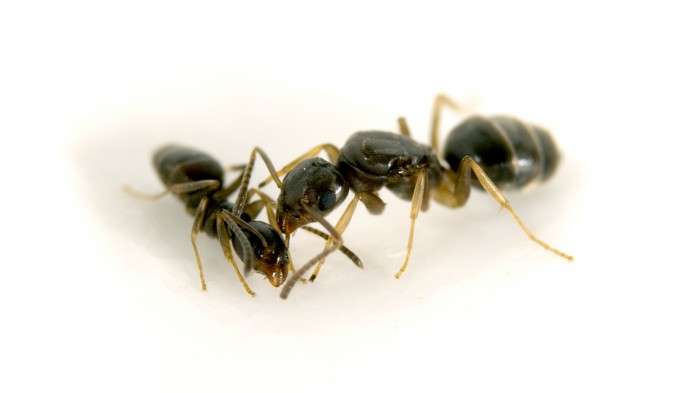Yes, that ant does smell like blue cheese

If you live in the United States, you've probably seen an odorous house ant (Tapinoma sessile) – one of the most common ants in the country. And for more than 50 years they've been described as smelling like rotten coconut. But Clint Penick thinks they smell like blue cheese. And he can prove he's right.
Penick is postdoctoral researcher at NC State. Most of his work revolves around ants, and for years he's been fascinated by the fact that you can identify some ant species by smell – such as T. sessile.
In grad school he heard that T. sessile smelled liked rotten coconut. But, not knowing what rotten coconut smelled like, he had no idea what that meant. And, since he went to grad school in the arid southwest (where T. sessile are rare), he had no chance to find out.
But after grad school he moved to North Carolina, where T. sessile are common. And when he found some T. sessile in his own backyard, he moved in for a sniff. Blue cheese. Not coconut-y at all.
So, being a scientist, Penick decided to do an experiment.
At the annual BugFest event held at the North Carolina Museum of Natural Sciences, Penick did a survey. He asked hundreds of people to smell T. sessile and fill out a survey on what they thought the ants smelled like.
The winner? Blue cheese.
And this is where the science really comes in.
To see if T. sessile really smelled like blue cheese, Penick got in touch with his friend Adrian Smith, a postdoc who studies chemical communication in social insects at the University of Illinois at Urbana-Champaign.
To analyze the characteristic smell of odorous house ants, the researchers placed an SPME fiber in a container with the ants to absorb their odor. They then did the same with a container full of blue cheese and a container containing coconut. The researchers then analyzed the chemicals caught by the SPME fiber using gas chromatography-mass spectrometry.
It turns out that the scents of blue cheese and T. sessile are both caused by the same class of chemicals, called methyl ketones. Coconut's smell wasn't related at all.
Then Penick tried one more thing: he buried the coconut in his yard.
When he dug the coconut up a week later, it was covered in a blue mold and smelled exactly like…blue cheese. When they tested it, Penick and Smith learned that the Penicillium mold on the coconut produces the same methyl ketones found in blue cheese.
"This was something Adrian and I did for fun – it's not something we spent tax dollars on," Penick says. "But while this started out as a joke, we got some interesting findings.
"For one thing, we've learned something new about one of the most common household pest species in the United States, and it's something people can use to describe the species to homeowners, students, and entomologists.
"But we also learned that T. sessile and the Penicillium molds are producing these similar methyl ketones," Penick says. "Why? We think it may have beneficial antimicrobial properties, but that remains to be explored."
A paper on the work, "The true odor of the Odorous House Ant," is published in the spring issue of American Entomologist.
More information: "The True Odor of the Odorous House Ant." DOI: dx.doi.org/10.1093/ae/tmv023 85-87
Provided by North Carolina State University





















